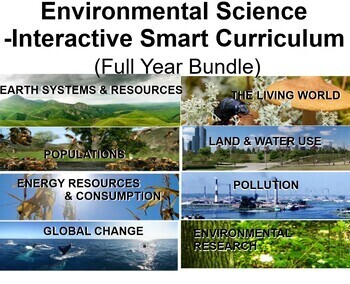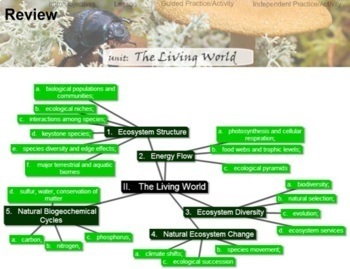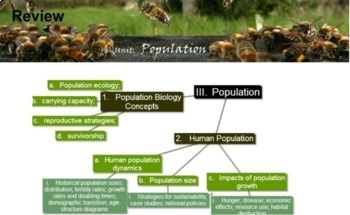Environmental Science -Interactive Smart Curriculum (Whole Course Bundle)
- Various file types
What educators are saying
Products in this Bundle (9)
showing 1-5 of 9 products
Bonus
Description
Is critical thinking using concrete examples and supported reasoning a priority in your classroom? Are you familiar with what cognitive psychologists have found to be the most effective strategies for student learning, such as Spaced Practice, Retrieval Practice, Elaboration, Interleaving, Concrete Examples, and Dual Coding? Are teacher-scientists catalysts for making that learning happen? This curriculum was designed with those very ideas in mind. I made it for myself because no other foundation like this existed. I am still actively teaching and improving it...and I believe TPT exists to help teachers to help each other to provide the best that they can offer their students.
Student work involves critical thinking and reinforced application of lessons. Consider some student feedback from this course:
- "Class was fun and very informative, Instructor had many different ways of learning including hands on experiments, notes, and videos, was an enjoyable class to take."
- "I really enjoyed the class ... have encouraged & strengthened my love for science and made me realize that this is where I want to go in life. I've Learned so much from you & this class"
- "I really enjoyed the class. I wasn't sure what to expect coming in, but it was really a great learning experience. Some of the things I already had a partial understanding of, but this class went very in depth and all the discussion and lessons really opened me up to a lot of new things I didn't know. And how so many things in life are connected. I don't have any 'helpful tips' of 'things to do better' because I honestly believe I got the most possible out of this class. It was my favorite! I believe you are doing an excellent job with this course -pushing us to use critical thinking and projects and such -I enjoyed it! Thanks!"
- "I like the applied areas of study a lot. It is amazing to see how studies of the river and storm drains can be so simple to do and learn from."
OK, WHAT IS THIS CURRICULUM? WHAT IS IT LIKE TO TEACH IT?
This is a year-long Whole Course Bundle of the Environmental Science -Interactive Smart Curriculum. Although no curriculum can replace a passionate and inspirational teacher, it is my hope that I can provide you with a well-planned curriculum that will save you time and give you the ability to focus your energy where it is needed.
The course was designed by a professional educator with a master's in environmental education. It is taught to juniors and seniors in high school as a science elective and is ready to be implemented and differentiated by other professional educators. The units are comprised of interconnected lessons, including daily "Focus Questions" and specific objectives.
Student tasks and assessments demonstrate the fulfillment of those same focus questions and objectives.
Care was taken in the planning stage to implement research-backed effective learning strategies throughout. This includes frequent and spaced connections to prior content. Each lesson incorporates direct and varied Independent Practice through meaningful applications and experiences of what students learn each day. In other words: The planning is mostly done, leaving you with the ability (privilege really) to expound, discuss, and explore the topics with students.
This is not a curriculum of worksheets and multiple-choice assessments. The Interactive refers to actual student activities, getting the students to do and experience stuff: see videos, read articles, listen to podcasts, perform mini-labs, engage in debates, create projects, make journal entries, play learning games, analyze, summarize, or illustrate lesson concepts...Interactive does not refer to gimmicky animations during the lesson presentations.
It is designed to make use of both guided and independent work and is suitable for one-on-one computer situations, in which students have access to computers or their own devices.
Proceed with confidence after checking out:
- View Preview icon above, which also includes a list of FAQs and Answers.
- More recent Q&A below.
- Multiple free Sample Lessons,
- An in-depth Video Overview of the download (9 min),
- Student comments shared above,
- Teacher comments (shared below this and the longer-standing Semester TPT products)
- An offer to email me to first freely preview and then "use as you see fit in your classroom" any unit in the curriculum. (email is given in video Overview and in all free downloads)
- Critical thinking is a priority. The first two lessons in this Course/Unit are foundational, and as such, they naturally dedicate classroom time to clarifying assumptions/worldviews. So please first check out the free downloads (Lesson 1 and Lesson 2) of these lessons to see if this is a fit for you!
WHAT WILL I GET?
This is a relatively newly Bundled product of a tried and tested curriculum [Used by over 200 Educators]. This bundle has the same materials as the Semester 1 (Units 1-4) and Semester 2 (Units 5-8) products. Enough material for an equivalent entire year-long course of about 180 periods of about 40 minutes each. This means it contains all 8 units shown above, plus bonus materials so that you have an entire year's worth of curriculum in one discounted product.
Contents:
- 8 Word Unit Plans that provide suggested course progression.
- over 143 Interactive lessons, in both Smart Notebook and PowerPoint Format.
- Daily formative Reviews that can be imported to use online via Socrative, displayed on-screen within the lesson, or shared/printed as PDFs.
- All supporting student handouts, for printing or digital sharing, are easily identified by the corresponding Lesson number in which they first appear.
- Examples of Student Work.
- Optional Digital Textbook of content as shareable [on secure school digital platform] or printable PDFs.
- A Materials/Equipment spreadsheet
- Cross-Cutting Concepts and Science and Engineering practices from NGSS
- Additional Support and Supplement material.
- An additional version of key lessons, with Biblical references as appropriate, for those who teach in a Christian School.
- Free anytime download updates from TPT.
2023-2024 Updates: Link checks and updates for Units 1-8 were completed this past Summer and are all set for this school year. Alignments for Indiana State Standards in Environmental Science were created.
Bonus Files Include:
- Materials Guide
- Semester Reviews and Exams.
- Supplemental Project Ideas.
- Directions for importing your own Planbook editable plans.
- Differentiated Options for Distance Learning: A spreadsheet to help you transition to distance learning -both live-virtual and asynchronously.
WHAT DO I NEED IN ORDER TO TEACH THIS?
In short: nothing more than what you would expect in a standard science classroom. Ideally, students will have one-on-one computer access. I would not recommend teaching this without individual or at least shared student computer access. Having a lab space/room is ideal for a few of the activities, but having access to an outside natural area on/near campus would be a significant benefit over the duration of the course. This course consists of more non-laboratory-type experiences and fieldwork than it does of traditional chemical/glassware lab-based experiences. Please check the Frequently Asked Questions at the end of the Preview file that accompanies this product. Also, check out any of the 8 Individual Units within the bundle or the Semesters 1 or Semester 2 products for further details. Email me if you would like copies of the Materials/Equipment lists.
Feel free to post a question on the Q&A for this product on TPT or reach out directly to me at the email found within any of my downloads or video overview and I will try to get back to you promptly.
YOUR PURCHASE MAKES A DIFFERENCE TO OTHERS TOO!
At select times throughout the year, portions of what is earned by the curriculum author through this product will go directly to the New Hope Foundation, Lifesong for Orphans, or other orphans in need. New Hope works with communities and caregivers to provide nurturing responsive care to the world’s most vulnerable young children. Its work is dear to my heart. Please consider visiting either New Hope or Lifesong's sites and making a contribution regardless of your purchase on TPT. Both are certified as Transparent through the charity evaluator Excellence in Giving.
Added note: if you read this far and classroom money is an issue, please reach out to me at the email found in any of my free downloads.
OTHER RELATED PRODUCTS:
All of these are included in this Environmental Science -Interactive Smart Curriculum (Whole Course Bundle)
Environmental Science: Semester 1 -Interactive Smart Curriculum
Unit 1: Earth's Systems and Resources
Environmental Science: Semester 2 -Interactive Smart Curriculum
Unit 5: Energy Resources and Consumption
Unit 8: Environmental Research
Distance Learning? This curriculum comes with a spreadsheet to help you transition to distance learning. Here is an example of what you can do for asynchronous. And here is how you can get going at shifting your classroom to do synchronous distance learning and/or asynchronous distance learning, in little time, for free, with this curriculum or any other.





